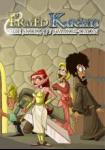
Frayed Knights - Traps Revised
Jay Barnson has been rethinking the way locks and traps work for Frayed Knights. Here are his ideas on how he could make them more user friendly:
So I'm working on abstracting out some of the details that made it overly complicated and confusing, but trying to keep the essence of the "mini-game" intact. The idea here was to make picking locks and disarming traps a little bit like combat, with lots of interesting choices in a race between the "disarm level" and the "danger level." (You want the former to hit the goal line before the latter does...
BASIC RULES
#1 - You goal is to to get the trap to 100% completion (fully disarmed) before it hits 100% danger level and goes off.
#2 - You get to 100% completion by fully disarming all of the components in a single category (triggers, mechanisms, or payloads).
#3 - Each component has a type, a difficulty level, a number of disarm stages (usually 1-3, but may be as many as 5), and a Threat Level.
#4 - You disarm a component by selecting it and pressing the Disarm button (or using an appropriate tool on it). If you succeed, you raise it one disarm stage. When you have filled in all the disarm stages, that component is now completely disarmed.
#5 - If you fail, the component's Threat Level (usually in a range of 10% - 50%) gets added to the trap's Danger Level.
#4 - If you abandon the lock prematurely, the lock may reset normally as in #3. Or, it may reset quietly, a turn still passes, but there's no enhanced chance of a wandering monster being attracted.
#6 - If the Danger Level hits 100%, the trap goes off, hitting the disarming character (and sometimes the entire party) with it's remaining (non-disarmed) payloads.
#7 - If you abandon a trap, there's a chance equal to its current Danger Level that it will go off anyway.
And THESE are still very subject to change based on playtesting results.
ADVANCED RULES
#8 - When you completely disarm a component, half of its threat value is SUBTRACTED from the danger level (to a minimum of zero).
This might make it worthwhile to tackle an easy component in a different category - just to jam stuff up more so the trap is less likely to go off.
#9 - On a Critical Success when disarming a component, the component will improve TWO disarm stages instead of just one.
#10 - On a Critical Failure when disarming a component, the component will increase the Danger level by 2x its Threat rating.
#11 - Each component has one of three types. The type and category dictate which tools work best with it. The type might not be visible - I haven't decided yet. But you should be able to guess based upon the name and the tool description. Some tools can be re-used, but the better ones will get used up.
#12 - Some tools are special-use items. For example, the 10-foot pole gives you a penalty on any disarm attempt, but gives you a bonus to avoid getting hit by the payload if the trap goes off.
#13 - If the trap goes off, only those non-disabled payloads will hit. So there may be an advantage to disarming the most dangerous payload even if you aren't focusing on the payload category.
#14 - You can swap out characters at any time. The game will default to the character with the highest skill. But if Dirk is low on hit points, you may want to tag him out with Arianna or someone else to try and complete the last couple of stages, just in case something goes wrong.
LOCK RULES
#1 - Locks are treated the same as traps, except there is no payload. Instead there's a lock category (the lock itself) and the mechanism category (whatever the lock holds in place). So, for example, on a padlock you can either try to pick the lock (disable the lock category), or go after the locking bar & shank in the "mechanism" category.
#2 - Regular tools will usually work on the "mechanism" category, but only special tools are required for the "lock" category (lockpicks and tension wrench). It's always assumed that your characters have SOME kind of lockpicks handy - the special lockpick tools are enhanced versions.
#3 - If the "Danger" level hits 100%, the lock resets noisily, a turn passes, and there's an enhanced chance of a wandering monster noticing your activity and coming by.
#4 - If you abandon the lock prematurely, the lock may reset normally as in #3. Or, it may reset quietly, a turn still passes, but there's no enhanced chance of a wandering monster being attracted.
Information about
Frayed KnightsSP/MP: Single-player
Setting: Fantasy
Genre: RPG
Platform: PC
Release: Released

